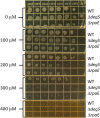Genome-wide characterization of Salmonella Typhimurium genes required for the fitness under iron restriction
- PMID: 35869435
- PMCID: PMC9308263
- DOI: 10.1186/s12863-022-01069-3
Genome-wide characterization of Salmonella Typhimurium genes required for the fitness under iron restriction
Abstract
Background: Iron is a crucial element for bacterial survival and virulence. During Salmonella infection, the host utilizes a variety of mechanisms to starve the pathogen from iron. However, Salmonella activates distinctive defense mechanisms to acquire iron and survive in iron-restricted host environments. Yet, the comprehensive set of the conditionally essential genes that underpin Salmonella survival under iron-restricted niches has not been fully explored.
Results: Here, we employed transposon sequencing (Tn-seq) method for high-resolution elucidation of the genes in Salmonella Typhimurium (S. Typhimurium) 14028S strain required for the growth under the in vitro conditions with four different levels of iron restriction achieved by iron chelator 2,2'-dipyridyl (Dip): mild (100 and 150 μM), moderate (250 μM) and severe iron restriction (400 μM). We found that the fitness of the mutants reduced significantly for 28 genes, suggesting the importance of these genes for the growth under iron restriction. These genes include sufABCDSE, iron transport fepD, siderophore tonB, sigma factor E ropE, phosphate transport pstAB, and zinc exporter zntA. The siderophore gene tonB was required in mild and moderate iron-restricted conditions, but it became dispensable in severe iron-restricted conditions. Remarkably, rpoE was required in moderate and severe iron restrictions, leading to complete attenuation of the mutant under these conditions. We also identified 30 genes for which the deletion of the genes resulted in increased fitness under iron-restricted conditions.
Conclusions: The findings broaden our knowledge of how S. Typhimurium survives in iron-deficient environments, which could be utilized for the development of new therapeutic strategies targeting the pathways vital for iron metabolism, trafficking, and scavenging.
Keywords: Conditionally essential genes; Salmonella Typhimurium; Tn-seq; iron-restriction.
© 2022. The Author(s).
Conflict of interest statement
The authors declare no conflict of interest.
Figures




Similar articles
-
Genetic Determinants in Salmonella enterica Serotype Typhimurium Required for Overcoming In Vitro Stressors in the Mimicking Host Environment.Microbiol Spectr. 2021 Dec 22;9(3):e0015521. doi: 10.1128/Spectrum.00155-21. Epub 2021 Dec 8. Microbiol Spectr. 2021. PMID: 34878334 Free PMC article.
-
Iron-dependent essential genes in Salmonella Typhimurium.BMC Genomics. 2018 Aug 14;19(1):610. doi: 10.1186/s12864-018-4986-1. BMC Genomics. 2018. PMID: 30107784 Free PMC article.
-
Dopamine Is a Siderophore-Like Iron Chelator That Promotes Salmonella enterica Serovar Typhimurium Virulence in Mice.mBio. 2019 Feb 5;10(1):e02624-18. doi: 10.1128/mBio.02624-18. mBio. 2019. PMID: 30723125 Free PMC article.
-
Evolution of Salmonella-Host Cell Interactions through a Dynamic Bacterial Genome.Front Cell Infect Microbiol. 2017 Sep 29;7:428. doi: 10.3389/fcimb.2017.00428. eCollection 2017. Front Cell Infect Microbiol. 2017. PMID: 29034217 Free PMC article. Review.
-
Molecular Profiling: Catecholamine Modulation of Gene Expression in Escherichia coli O157:H7 and Salmonella enterica Serovar Typhimurium.Adv Exp Med Biol. 2016;874:167-82. doi: 10.1007/978-3-319-20215-0_7. Adv Exp Med Biol. 2016. PMID: 26589218 Review.
Cited by
-
New insights on an old friend: AroA linked to iron-dependent outer membrane stability.mBio. 2024 Dec 11;15(12):e0279924. doi: 10.1128/mbio.02799-24. Epub 2024 Nov 21. mBio. 2024. PMID: 39570017 Free PMC article.
-
ZntA maintains zinc and cadmium homeostasis and promotes oxidative stress resistance and virulence in Vibrio parahaemolyticus.Gut Microbes. 2024 Jan-Dec;16(1):2327377. doi: 10.1080/19490976.2024.2327377. Epub 2024 Mar 11. Gut Microbes. 2024. PMID: 38466137 Free PMC article.
-
Comparative Genomic Profiles of Salmonella Typhimurium and Salmonella Dublin Bovine Isolates from the U.S. Indicate Possible Factors Associated with the Host Adaptation of Salmonella Dublin in the Region.Microorganisms. 2025 Apr 12;13(4):886. doi: 10.3390/microorganisms13040886. Microorganisms. 2025. PMID: 40284722 Free PMC article.
-
Production of the siderophore lysochelin in rich media through maltose-promoted high-density growth of Lysobacter sp. 3655.Front Microbiol. 2024 Jun 26;15:1433983. doi: 10.3389/fmicb.2024.1433983. eCollection 2024. Front Microbiol. 2024. PMID: 38989020 Free PMC article.
References
Publication types
MeSH terms
Substances
LinkOut - more resources
Full Text Sources
Medical
